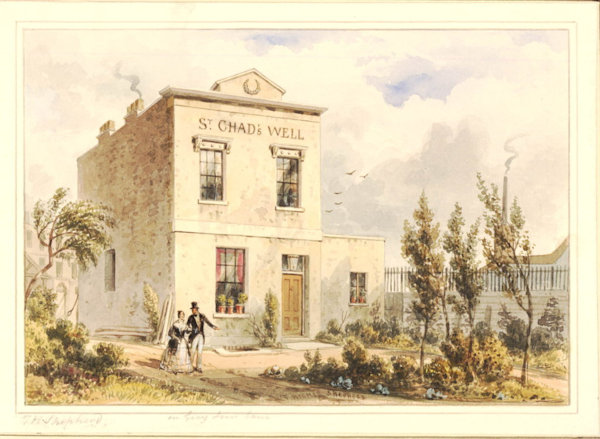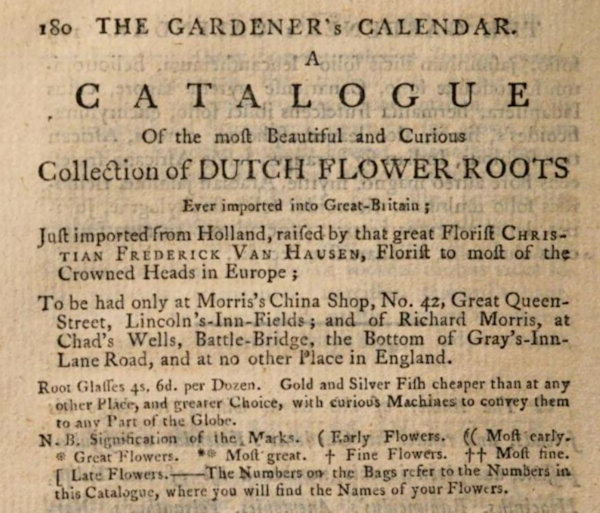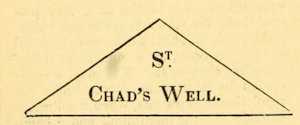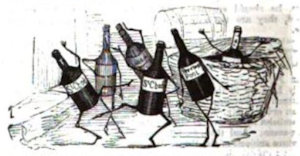 |
Dedication: Saint Chad Location: Battlebridge, Islington Coordinates: 51.53038N, -0.12006W Grid reference: TQ305829 Status: destroyed |
 |
Dedication: Saint Chad Location: Battlebridge, Islington Coordinates: 51.53038N, -0.12006W Grid reference: TQ305829 Status: destroyed |
St Chad, a 7th century missionary who has now become the patron saint of medicinal springs, has no direct links to London; his brother Cedd, however, does, although only very loosely. In the mid 7th century, Cedd is said to have been appointed as the Bishop of the East Saxons by St Finan, and, as London formed part of that area, Cedd is generally given the title of the "Bishop of London", although it is not known whether he actually spent much time there. It is possible that the spring was originally dedicated to St Cedd, and, through corruption, became associated with his brother Chad. Alternatively, the well may simply have acquired Chad's name because of his immense popularity during the medieval period.
The earliest reference that I could find to the well is in a letter that is dated to the 13th of September 1666, which was sent by a man named Henry Foxall to a man named Charles Firebrace. The letter was transcribed by the anonymous "editor" of a small book named Mother Red Cap (the majority of the letter dealt with the story of Mother Red Cap) in 1843, who claimed that his friend, a Mr Noah Iddeffsaton, had inherited a "chest of papers" that were sent to him from America after his distant ancestor died; according to the "editor", Iddeffsaton gave this chest of papers to the "editor" for him to examine. This letter is said to have been one of those contained within the chest. In this letter, the spelling and grammar of which was presumably modified by the "editor", as it reads nothing like a 17th century text, Henry Foxall states that "on passing Saint Chad's Well, and over Battle-bridge, the doctor, who was an antiquarian, did not fail to discourse on the limpid waters of the River Fleet".
Many references to the well were made in the late 18th century; from this fact alone, it appears that the well, in its new guise as a medicinal spa, gained more attention after the Reformation than before it, possibly because there were simply so many holy wells in the area in medieval times that St Chad's Well would not have been anything special. According to an article in the volume 4 of the Punch magazine (published in 1843), "in the middle of the eighteenth century the waters were in high repute, and frequently were visited by eight or nine hundred persons in a morning". An advertisement of 1782, which appears in The Gardener's Calendar, and Florist's Guide, by James Mair, informs the reader of "the moſt Beautiful and Curious Collection of DUTCH FLOWER ROOTS ever imported into Great-Britain", which, it states, can "be had only" at one of two places: "Morris's China Shop", and "Chad's Wells, Battle-Bridge".
 |
A decade or so later, in 1795, David Lysons mentioned the well in a publication that was entitled "The Environs of London":
|
Near Battlebridge is a ſpring, called St. Chad's-well, of nearly the ſame quality [as St Pancras' Well], which is ſtill in uſe. |
In 1798, the site attracted attention when the proprietor of the wells, a man named Mr Salter, was found dead in a pond in the surrounding gardens, having drowned. His obituary was included in a section of volume 84 of the Gentleman's Magazine entitled "Orbituary of Remarkable Perſons; with Biographical Anecdotes", which is written under the date of the 17th of July, 1798:
|
Found drowned in a pond in the garden belonging to St. Chad's well, at the bottom of Gray's-inn-lane, Mr. Salter, who had for many years been part proprietor thereof. A derangement of mind, which it is rather ſuppoſed he had been labouring under ſome time paſt (he having once or twice attempted to deſtroy himſelf), was the cause of this ſhocking affair. He was 72 years of age, and is thought to have acquired a conſiderable property; but, having built a very large houſe adjoining the garden, for the purpose of converting them into tea-gardens, and not being able to obtain a licence, it is ſuppoſed the diſappointment made him commit the raſh act. |
During the late 18th century, the well was also mentioned in Bowles's New London Guide (1786) as "St. Chad's wells, Battle bridge"; and in Ambulator, (1793-4), which states that "near Battle-bridge is another [well] called St. Chad's".
Despite the apparent popularity of St Chad's Wells during the 18th century, the site began to fall into disrepair in the early 19th century. In London; Being an Accurate History and Description of the British Metropolis, David Hughson, who described the water as being "impregnated with calcereous nitre", noted in 1809 that the site was "of much resort to the lower classes of tradesmen on Sunday mornings". In 1925, William Hone, who stated that "St. Chad's Well is haunted, not frequented", provided a detailed description of the state of the well as part of The Every Day Book:
|
Opposite this unsightly site [a large "heap of cinder-dust"], and on the right-hand side of the road is an angle-wise faded inscription: "ST. CHAD'S WELL." It stands, or rather dejects, over an elderly pair of wooden gates, one whereof opens on a scene which the unaccustomed eye may take for the pleasure-ground of Giant Despair. Trees stand as if made not to vegetate, clipped hedges seem willingly to decline, and nameless weeds straggle weakly upon unlimited borders. If you look upwards you perceive painted on an octagon board "Health Restored and Preserved." Further on towards the left, stands a low, old-fashioned, comfortable-looking, large windowed dwelling; and ten to one, but there also stands, at the open door, an ancient ailing female, in a black bonnet, a clean coloured cotton gown, and a check apron; her silver hair only in part tucked beneath the narrow border of a frilled cap, with a sedate and patient, yet, somewhat inquiring look. This is "the Lady of the Well." She gratuitously informs you, that "the gardens" of "St. Chad's well" are "for circulation" by paying for the water, of which you may drink as much, or as little, or nothing, as you please, at one guinea per year, 9s. 6d. quarterly, 4s. 6d. monthly, or 1s. 6d. weekly. You qualify for a single visit by paying sixpence, and a large glass tumbler full of warm water is handed to you. As a stranger, you are told that St. Chad's well was famous at one time. Should you be inquisitive, the dame will instruct you, with an earnest eye, that "people are not what they were,'' "things are not as they used to be," and she "can't tell what'll happen next." Oracles have not ceased. While drinking St. Chad's water you observe an immense copper into which it is poured, wherein it is heated to due efficacy, and from whence it is drawn by a cock, into the glasses. You also remark, hanging on the wall, a "tribute of gratitude" versified, and inscribed on vellum, beneath a pane of glass stained by the hand of time and let into a black frame: this is an effusion for value received from St Chad's invaluable water. But, above all, there is a full-sized portrait in oil, of a stout, comely personage, with a ruddy countenance, in a coat or cloak, supposed scarlet, a laced cravat falling down the breast, and a small red night cap carelessly placed on the head, conveying the idea that it was painted for the likeness of some opulent butcher who flourished in the reign of queen Anne. Ask the dame about it, and she refers you to "Rhone." This is a tall old man, who would be taller if he were not bent by years. "I am ninety-four," he will tell you, "this present year of our Lord, one thousand eight hundred and twenty-five." All that he has to communicate concerning the portrait is, "I have heard say it is the portrait of St. Chad." Should you venture to differ, he adds, "this is the opinion of most people who come here." You may gather that it is his own undoubted belief. St Chad's well is scarcely known in the neighbourhood, save by its sign-board of invitation and forbidding externals. An old American loyalist, who has lived in Pentonville ever since "the rebellion" forced him to the mother country, enters to "totter not unseen" between the stunted hedgerows: it was the first "place of pleasure" he came to after his arrival, and he goes no where besides, - "every thing else is so altered." For the same reason, a tall, spare, thin-faced man, with dull grey eyes and underhung chin, from the neighbourhood of Bethnal-green, walks hither for his "Sunday morning's exercise," to untruss a theological point with a law clerk, who also attends the place because his father, "when he was prentice to Mr. ----- the great law stationer in Chancery-lane in 1776, and sat writing for sixteen hours a day, received great benefit from the waters, which he came to drink fasting, once a week." |
The "tribute of gratitude versified" that Hone mentions, though now long lost, was recorded by the aptly named Thomas Cromwell in 1835 in Walks Through Islington, and it is said to have stated:
|
Oh! did Physicians, to their judgment true, |
(George Clinch also recorded the rhyme in 1890 in Marylebone and St. Pancras, but his version is slightly different to Cromwell's, possibly because Clinch was writing around thirty years after the well had been destroyed, by which time the verse may have become slightly muddled.)
Likely because of the site's steady decline, St Chad's Wells was auctioned off at Garraway's Coffee House in Cornhill on the 14th of September, 1837, to a man named William Lucas, who took it on as a commercial venture. It appears that either one of his relatives or he himself owned a large portion of land adjoining St Chad's Wells. A copy of "the particulars and conditions of the sale" was transcribed by William J. Pinks in the late 19th century, and was published in The History of Clerkenwell in 1865. In this document, it was stated that the site would "produce an inexhaustable [sic] revenue" (in the "proper hands", of course), and the premises were valued at, "per annum, £60 - £81 10s", which is, in today's money, around £4,500 to £5,000. Pinks also described a plan of the estate that came with the document:
|
...a forecourt or garden adjoined Gray's Inn-road; next to the forecourt were the house and pump-room; and beyond them was the garden, in which on the north side were eleven water-closets. North of the forecourt was a school-room. In one corner of the garden were the premises let to Mr. Kirby, and a shed; and in another corner the premises let to Mr. Askew. On the north the garden was joined by the backs of the houses in Cumberland-row, and on the south by a timber yard. The shape of the whole estate was somewhat like an obtuse-angled triangle. |
William Lucas, the new proprietor, almost immediately set to work attempting to publicise his new business. He began to print and distribute handbills that boasted of the healing virtues of the water and claimed that St Chad himself was healed by the spring; it is not clear whether this increased the amount of visitors, but it appears to have attracted some attention, as the majority of publications that reference St Chad's Wells were written in the decades immediately following the 1840s. Lucas also distributed hampers containing two dozen bottles of water to anywhere in the country, at the hefty price of £1; it is possible that his predecessors did this too. (The image above, an illustration of St Chad's Wells, dates from 1840.) One of these handbills, printed in 1840, was transcribed by William J. Pinks in, again, The History of Clerkenwell:
|
Spring of many Virtues, St. Chad's Wells, Gray's Inn-road, near King's-cross, Battle-bridge. The celebrity of these waters being confined chiefly to its own immediate vicinity for a number of years, the present proprietor has thought proper to give more extensive publicity to the existence of a nostrum provided by nature, through Divine Providence, approaching nearest the great desideratum of scientific men, and mankind in general throughout all ages; namely, an universal medicine. The frequently attested evidence of those relieved, and their fervent regret that the existence of such an immense benefit to mankind should be so little known, has been the cause of calling forth the present medium of communicating a source of relief to the sufferer. The antiquity of the springs is very remote, but the exact time or circumstance of their first introduction to public notice is not left on record; but there is every reason to believe in their early existence; for, in keeping with the general practice of our forefathers, when each medicinal spring had its tutelar Saint, to whose pious influence its healing properties were ascribed, this spring was dedicated to St. Chad, first Bishop of Lichfield, who was healed by these waters of a disease he suffered from, and thus originated the name by which it is at present known. The many cures yearly performed by these waters does not come within the limits of a handbill, but suffice it to say that here upon trial the sufferer finds a speedy and sure relief from indigestion and its train, habitual costiveness, the extensive range of liver complaints, dropsy in its early stages, glandular obstructions, and that bane of life, scrofula; for eruptions on the face and skin its almost immediate efficacy needs but a trial. The evidence of the frequenters of the pump-room is the strongest testimony that can be offered the suffering part of the community. Pamphlets may be had at the pump-room, in which is set forth more fully the healing properties of this medical spring. The pump-room and gardens are tastefully arranged, and fitted up with attention to the convenience, &c., of the invalid, the latter affording a pleasant walk for visitors. These waters retain their properties any length of time in closely-stopped bottles. Terms, yearly subscribers, £1; half-year's, 12s.; quarterly ditto, 7s. 6d.; monthly, 3s.; weekly, 1s.; visitors each, 3d. The waters, 8d per gallon. Open from 5 o'clock in the morning. |
The equivalents in today's money of the "terms" are as follows: "yearly subscribers", £60; "half-year's", £35; "quarterly", £20; "monthly", £10; and "weekly", £3. 3d is today equivalent to just less than £1, and 8d is equivalent to just over £2. The pamphlet that is referred to above, which was entitled "Treatise on the Characteristic Virtues of the Saint Chad's Well's Aperient and Alternative Springs" was also transcribed by Pinks, and is almost identical in content to the handbill. The pamphlet does, however, describe in more detail the quality of the water, and makes clear that the water is "perfectly clear and pellucid, and sparkles when poured into a glass; to the taste it is slightly bitter, not sufficiently so to render it disagreeable". The water is said to be so "palatable" that people often "take it at the table for a common beverage". In conclusion, the spring water is stated to be "actively purgative, mildly tonic, and powerfully diuretic".
Shortly after the handbill and pamphlet were published, a piece about the well was included in volume 4 of the Punch magazine, in 1843. It included an extremely meticulous description of the interior of the pump-room, and, as the article references the handbill and pamphlet, it appears that Lucas' efforts to attract more visitors had an effect. Part of the article has been transcribed below:
|
Entering the Pump Room, by the method common in establishments of this kind, of going through the door, the first thing to be observed is the Pump itself, standing against the wall on the right, a chaste structure, very like a common one, and ornamented with two brass cocks and a handle. It is surmounted by an image of Victory, in Paris plaster, indicative of the triumph of Temperance, tilting forward upon tiptoe and holding a wreath over the marble font below; as well as the Joans of Arcs, which doubtless embody some hidden allegory connected with the fortitude necessary to drink the water. The pump is defended by a semicircular bar of painted wood, upon which the miraculous fluid is retailed at a fixed sum the ginger-beer-glassful. The priestess of the institution, who dispenses the inestimable draught, was at the bar when we entered. But upon our appearance she started with affright, and fled like a timid fawn to some inner chamber under the double influence of surprise and hair-papers, for it was yet morning. But she left in her place an interesting boy, who upon being asked "how much of the fluid was a average dose?" ingeniously replied, "Thrippunce a pint;" and then inquired "whether we liked it with the chill off?" For an instant we turned away in anger, imagining that the youth took advantage of our defenceless position in such a wild region of solitude, to insult us. But we must do him the justice to say, however, that contrary to his question being the application of a common phrase, there were actually the means of warming the water for delicate stomachs. The taste of the water from ST. CHAD'S WELLS is certainly more peculiar than pleasant, being something between ink and Epsom salts, with a dash of soapsuds, held in solution. |
The piece appears to have been written more in the vein of yet another advertisement than as an informative article, and, in keeping with its purpose, the text finishes with a warning to its readers:
|
CAUTION: The public are respectfully informed that the true St. Chad's Spring can only be obtained, where it is allowed to be drunk, on the premises. Unprincipled individuals have christened a thoroughfare leading from Myddleton Square to St. John Street Road Chadwell Street (observe the subterfuge of the Chad), to mislead valentudinarians, and foist their New River trash upon the public as the real article. None is genuine unless visitors go at once to the Fountain-head. |
St Chad's Wells is also said to have had several interesting visitors, including Joseph Munden (1758-1832), a popular comedian and actor of the time who, according to a piece in volume 32 of The Builder (1874), "made a point of visiting St. Chad's Well three times a week to drink the waters"; slightly contradictorily, John Doran, in Saints and Sinners (1868), stated that "there are many yet living" who remembered Munden "walking daily" to the well. According to Doran, "Munden believed in St. Chad, and had faith in the healing powers of his fountain". Another famous visitor was The Right Honourable Sir Alan Chambre, who was a well known English judge in the Court of Common Pleas during the 18th and early 19th centuries; it is said, in The Builder, that he "did the same" as Munden when he lived in Highgate. According to Thomas Cromwell (as mentioned above), writing in 1835 in Walks Through Islington, John Abernethy, a prominent surgeon of the late 18th and early 19th centuries, who invented the "Abernethy biscuit", a type of digestive biscuit, visited the wells and "was accustomed to speak in terms of praise of their salutary qualities". Several publications also make reference to a Mr Alexander Mensall, the headmaster of Gordon House Academy, who, Warwick Wroth in The London Pleasure Gardens of the Eighteenth Century (1896) claims, "used to march his young gentlemen to St. Chad's once a week in order to save in doctor's bills".
Despite the fact that the well was rather popular during the Victorian era, it was unfortunately destroyed at some point in the 1860s to make way for the Metropolitan Railway, which still dominates the site today, and the water from the spring is presumably piped off to join a sewer.
 |
 |
Copyright 2025 britishholywells.co.uk